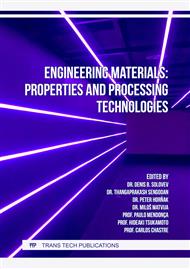[1]
Yu.S. Volkov, Self-compacting mix – a milestone in concrete technology, Concrete technology. 9 (2014) 30-35, 10 (2014) 28-34.
Google Scholar
[2]
V.V. Babkov, A.S. Salov, A.A. Plax, G.S. Kolesnik, R.R. Sakhibgareev, Problems of efficient application of high-strength concretes in reinforced concrete structures, Housing construction. 10 (2009) 43.
Google Scholar
[3]
V.V. Babkov, R.R. Sakhibgareev, G.S. Kolesnik, V.V. Kabanets, I.G. Terekhov, A.S. Salov, R.R. Sakhibgareev, R.Z. Karanaeva, Ye.B. Savateev, Rational areas for application of modified concretes in modern construction, Construction materials. 10 (2006) 20-23.
Google Scholar
[4]
A.S. Salov, Problems of optimum application of high strength concretes and efficient grades of rebars in bending structures, Materials for XV academic readings of Russian Academy of Architecture and Construction Sciences – International Science and Technology Conference, Achievements and problems of material engineering and developments of construction industry, 2010, pp.58-61.
Google Scholar
[5]
R.F. Vagapov, D.A. Sinitsyn, A.A. Oratovskaya, G.V. Tanenbaum, Use of industrial wastes under manufacturing of construction materials illustrated by the Republic of Bashkortostan, News of SWSU. 3(54) (2014) 76-82.
Google Scholar
[6]
G.V. Nesvetaev, Self-consolidating concrete technology, Construction materials. 3 (2008) 24–28.
Google Scholar
[7]
R.F. Vagapov, D.A. Sinitsyn, A.A. Oratovskaya, G.V. Tanenbaum, Industrial waste construction materials in the Republic of Bashkortostan, News of Kazan Architectural and Construction University. 4(22) (2012) 279-284.
Google Scholar
[8]
A. Bedov, A. Salov, A. Gabitov, CAD methods of structural solutions for reinforced concrete frame, XXI International Scientific Conference on Advanced in Civil Engineering "Construction - The Formation of Living Environment" (FORM 2018) 25–27 April 2018, Moscow, Russian Federation. Vol. 365 (2018) 1-8.
DOI: 10.1088/1757-899x/365/5/052032
Google Scholar
[9]
A.S. Salov, Calculation of efficient variational cross-section and variational reinforcing of bending reinforced concrete element by criterion for reducing material consumption and efficient combination of concrete and rebar grades: Certificate of state registration for PC application No 2011613598; rightholder GOU VPO UGNTU; pending 21.03.2011; registered 05.05.2011.
Google Scholar
[10]
A.S. Salov, Optimization of design solutions for reinforced concrete frame without collar beams under application of high grade concretes and rebars, thesis for the degree of Ph.D, in Engineering Science, Samara State Architectural-Construction University, Samara, 2011.
Google Scholar
[11]
A.S. Salov, Problems for optimum application of high-strength concretes and efficiency grade rebars in bending structures, Materials of XV academic readings of Russian Academy of Architecture and Construction Sciences – International Science and Technology Conference, Achievements and problems of material engineering and developments of construction industry, 2010, pp.58-61.
Google Scholar
[12]
A.I. Bedov, A.I. Gabitov, A.M. Gaisin, A.S. Salov, A.R. Chernova, CAD technologies under thermal properties analysis of wall cladding of framed buildings, IOP Conference Series: Materials Science and Engineering: Volume 465, VII International Symposium Actual Problems of Computational Simulation in Civil Engineering 1–8 July 2018, Novosibirsk, Russian Federation, pp.1-8
DOI: 10.1088/1757-899x/456/1/012065
Google Scholar
[13]
A.I. Bedov, A.I. Gabitov, A.M. Gaisin, A.S. Salov, A.R. Chernova, CAD analysis for stress and strain behaviour of masonries made of hollow ceramic blocks, IOP Conference Series: Materials Science and Engineering: Volume 465, VII International Symposium Actual Problems of Computational Simulation in Civil Engineering 1–8 July 2018, Novosibirsk, Russian Federation, pp.1-7.
DOI: 10.1088/1757-899x/456/1/012066
Google Scholar
[14]
O.N. Bolotskikh, Self-consolidating concrete and its diagnostics, Buildings and structures prevention from crashes (2010).
Google Scholar
[15]
A.I. Bedov, V.V. Znamensky, A.I. Gabitov, Structural assessment, renovation and strengthening of frames of operating buildings and structures, Structural survey and assessment of frames of operating buildings and structures, M: ASV Press, 2014, p.704.
Google Scholar
[16]
A.I. Bedov, A.S. Salov, A.I. Gabitov, D.V. Kuznetsov, E.A. Sadykova, Computer technologies in formation of computed models of monolithic reinforced concrete structures, International Journal for Computational Civil and Structural Engineering. Vol. 13, 4 (2017) 37-46.
DOI: 10.22337/2587-9618-2017-13-4-37-46
Google Scholar
[17]
A.I. Bedov, V.V. Babkov, A.I. Gabitov, A.S. Salov, Application of high performance concrete and rebars in engineering of precast and reinforced concrete structures, Bulletin of MGSU. 8 (2012) 76-84.
DOI: 10.22227/1997-0935.2012.8.76-84
Google Scholar
[18]
A.R. Solovjanchik, V.N. Korotin, I.S. Pulyaev et al., Experience in applying self-consolidating concrete mix at construction of bridges and tunnels, Alitinform. Cement. Concrete. Dry mix. 3(25) (2012) 8–21.
Google Scholar
[19]
V.I. Kalashnikov, Calculation of high strength self-consolidating concrete compositions, Construction materials. 10 (2008) 4–6.
Google Scholar
[20]
G.V. Nesvetaev, Some issues in applying admixtures to concrete, Concrete and reinforced concrete. 2 (2011) 78–80.
Google Scholar


